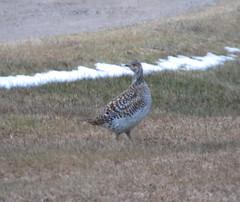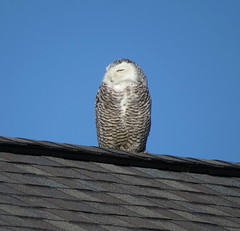Shawnee Lookout Forest and the Oxbow
There were frost warnings out for the Tri-state area as I made my way over to pick up Jon for some very early migrant birding. Both Shawnee Lookout and the Oxbow can be particularly good, so with the rising sun low on the horizon we set off in a westerly direction.
Shawnee Lookout was practically empty as we set off on a couple of trails, always listening and watching. As we walked we chatted about which early migrant might make an appearance today. One at the top of the list was the Hermit Thrush. The reclusive skulker of the undergrowth is usually heard before it’s seen.
So it came as no surprise that one of the birds we stumbled across, right next to the trail was a Hermit Thrush eating a worm.
 If you look real close you can see the worm on the ground.
If you look real close you can see the worm on the ground.
Yellow-rumped warblers were the dominate, and only warbler species seen at Shawnee Lookout. In a couple of weeks this place will be crawling with migrating warblers, but this day wasn’t meant to be. However the male Butter-butts were all dressed in their best breeding plumage, and really it’s only a matter of time before more show up.
So as we were leaving Shawnee Lookout a question arises. We all know what happens when the chicken crosses the road, but what about the Wild Turkey?
After a short stop at Lost Bridge to count the Pectoral Sandpipers and a couple American Pipits, we arrived at the Oxbow. And quite honestly I don’t know what impressed us the most, the sheer number of Double-creasted Cormorants (we estimated about 250) or the Bald Eagles, ( which we counted 18 of them).
 This immature Bald Eagle landed real close to Jon and me with a fish, and proceeded to eat it. I tried to sneak up it and get a better photo, but he didn’t that too much and promptly left.
This immature Bald Eagle landed real close to Jon and me with a fish, and proceeded to eat it. I tried to sneak up it and get a better photo, but he didn’t that too much and promptly left.
 Nothing quite as pretty as a Bald Eagle against a blue sky.
Nothing quite as pretty as a Bald Eagle against a blue sky.
At one time as we approached a line of trees that separates two fields we counted 12 individual Bald Eagles. It was quite a sight, but considering the distance a photo wouldn’t have done justice. However the bird of the day was yet to come.
As we continued driving along the dirt road that cuts through the Oxbow we notice small brown birds foraging along the edge. And one had white edges on the tail. I quickly pull over as we get our bins on the bird. Vesper Sparrow. Very good bird, especially for this part of Ohio.
Now you might be saying to yourself that this is a pretty common bird where I live, but in southern Ohio we have maybe a 2 week window where Vesper Sparrows can be seen before they move North. And this one cooperated.
 That’s the thing with Jon and me, we love Sparrows, and for us this was a great bird.
That’s the thing with Jon and me, we love Sparrows, and for us this was a great bird.
We made one more stop in Lawrenceburg Indiana where we walked a bike trail hoping to pick up the same birds we saw there during the Christmas Bird Count.
It was a good day. Notable birds for the day include:
- Black Vulture
- Turkey Vulture
- Bald Eagle
- Red-tailed Hawk
- American Kestrel
- Wood Duck
- Mallard
- Northern Shoveler
- Blue-winged Teal
- American Coot
- Pied-billed Grebe
- Hooded Merganser
- Great Blue Heron
- Great Egret
- Double-creasted Cormorant
- Wild Turkey
- Mourning Dove
- Pileated Woodpecker
- Red-bellied Woodpecker
- Hairy Woodpecker
- Downy Woodpecker
- Northern Flicker
- Blue Jay
- Eastern Phoebe
- American Crow
- Tufted Titmouse
- Northern Cardinal
- Carolina Chickadee
- Carolina Wren
- Yellow-rumped Warbler
- Yellow-throated Warbler
- Ruby-crowned Kinglet
- Golden-crowned Kinglet
- White-breasted Nuthatch
- Hermit Thrush
- American Robin
- Brown-headed Cowbird
- European Starling
- Common Grackle
- Red-winged Blackbird
- Eastern Towhee
- White-crowned Sparrow
- White-throated Sparrow
- Song Sparrow
- Vesper Sparow
- Field Sparrow
- Chipping Sparrow
- House Finch
- American Goldfinch
- Canada Goose
- American Pipit
- Pectoral Sandpiper
- Killdeer
- Ring-billed Gull
- Bonaparte’s Gull
- Northern Rough-winged Swallow
- Tree Swallow






















